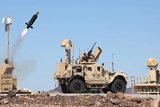US industry continues efforts to enhance airborne autonomy
MQ-20 Avenger UAV. (Photo: General Atomics)
General Atomics announced on 11 August that an Avenger UAS, equipped with a Lockheed Martin Legion Pod containing an IRST21 search and track system, autonomously tracked and followed a target aircraft in a July 2021 industry-funded demonstration.
Chris Pehrson, GA-ASI VP of special programmes, said: ‘The success of this Avenger/Legion Pod demonstration represents an important step toward more sophisticated autonomous missions for unmanned aircraft and MUM-T [manned-unmanned teaming] in a complex battlespace.’
Integrating Legion Pod software into the Avenger Mission Management System took less than three months and was enabled through Open Mission System standards.
During the flight, Legion Pod with IRST21 detected multiple fast-moving aircraft operating in the area and fed target tracking information to the autonomy engine aboard Avenger autonomy engine, which prioritised the targets for engagement.
‘This flight demonstrates a critical sensor capability that enables unmanned combat air vehicles like the Avenger to operate autonomously in Joint All-Domain Operations,” said Dave Belvin, VP of Sensors and Global Sustainment at Lockheed Martin.
He added: ‘We designed Legion Pod to passively detect and track targets for tactical fighter pilots in radar-denied environments. This capability provides the data necessary to enable unmanned vehicles to track and engage hostile airborne targets without human intervention.’
Related Equipment in Defence Insight
More from Air Warfare
-
![India readies private sector push as AMCA moves towards 2028 prototype]()
India readies private sector push as AMCA moves towards 2028 prototype
India’s stealth fighter ambitions gain fresh momentum as HAL opens the door to private sector involvement in AMCA Mk1A structural assembly, with strategic support growing for next-gen propulsion and sensor technologies.
-
![BAE Systems reveals new GCAP demonstrator design with plans to fly by 2027]()
BAE Systems reveals new GCAP demonstrator design with plans to fly by 2027
A key part in the trinational Global Combat Air Programme (GCAP), this is the first crewed supersonic aircraft demonstrator to be built and developed in the UK in more than 40 years.
-
![Anduril’s Barracuda-100M completes latest successful test flights]()
Anduril’s Barracuda-100M completes latest successful test flights
The munitions variant of the Barrauda-100 autonomous air vehicle is being tested for the US Army’s High-Speed Manoeuvrable Missile (HSMM) testbed programme, with further flight tests expected in 2026.





















